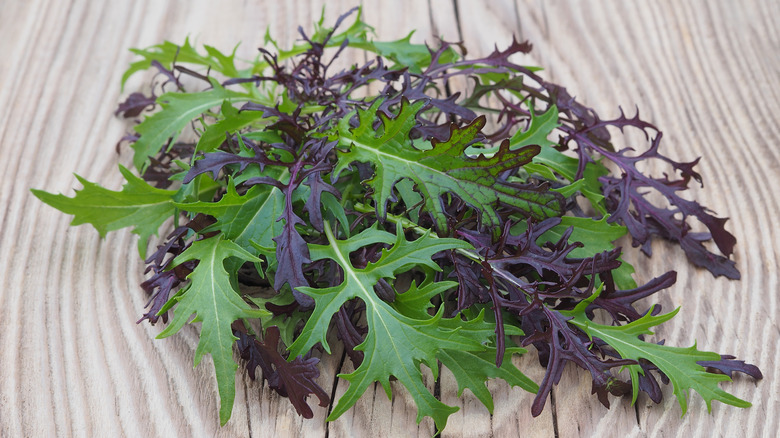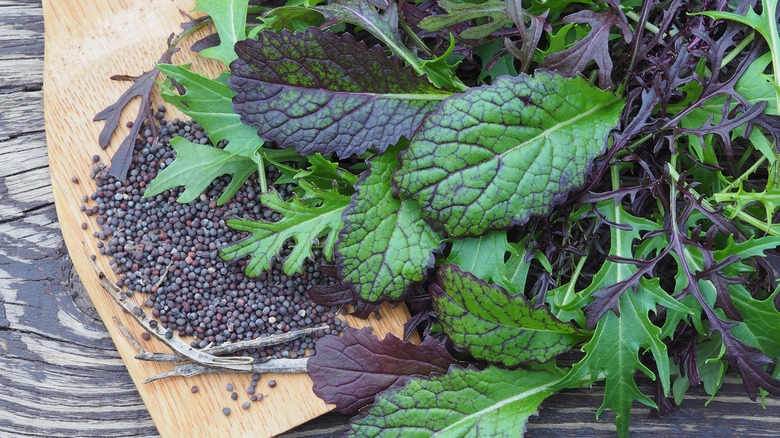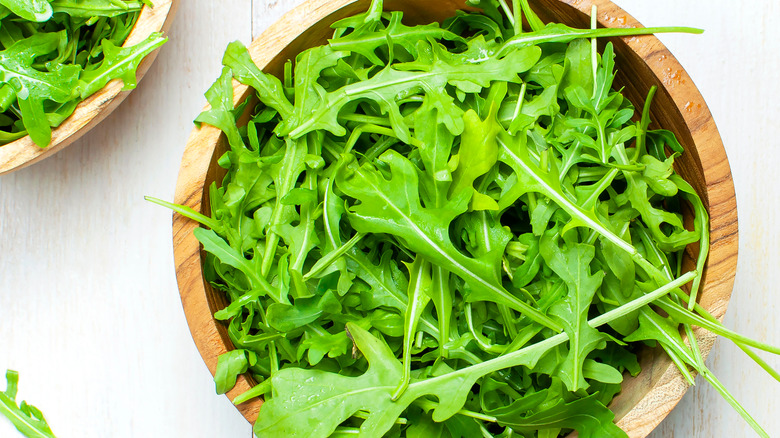What Is Mizuna And What Does It Taste Like?
Mizuna, also known as konya, Japanese mustard greens, "spider" mustard, or California peppergrass (via via USDA and Morning Chores) is a leafy green vegetable that can be cooked or used in salads. The Japanese began to cultivate mizuna widely in the mid-19th century, and thereafter, emigrants introduced it throughout the world; it can now be found in specialty grocers in Europe, Asia, Australia, and the U.S., according to Specialty Produce. Most often, you'll find it incorporated in mixed salad greens.
Mizuna is a member of the Brassica or "Cruciferae" family of vegetables, which also includes kale, Brussels sprouts, bok choy, radishes, cabbage, broccoli, and cauliflower. This leafy green is easy to grow because it's tolerant to both hot and cold temperatures, and it can be cultivated in all parts of the U.S., according to the University of Tennessee.
Mizuna's greatest claim to fame, however, has to be its role on the International Space Station. Astronauts grew and ate mizuna in 2019 as part of a NASA experiment aboard the famous spacecraft. Designed to examine the possibility of Space Station crews growing their own food, the project, called VEGGIE, utilized growing "pillows" rather than soil as a growing medium for the greens (via NASA). Fast-growing mizuna translates to "water greens," as they were able to grow and thrive in the flooded fields of Japan (via Specialty Produce).
Types of mizuna
According to Healthline, horticulturists have identified 16 varieties of this mustard-like green. While similar, they have subtle differences in color, texture, and taste. These varieties include kyona, which features long, thin, white stalks and leaves with distinctively serrated leaves. Komatsuna features deep green, rounded leaves and is resistant to heat and diseases. Red Komatsuna has rounded maroon leaves. The Vitamin Green variety of mizuna grows well in hot and cold temperatures. Happy Rich is the most distinctive variety of mizuna, and produces tiny broccoli-like florets. Other varieties (via Morning Chores) include Beni Houshi, which features purple stems and are exceptionally high in antioxidants. And the lovely Japanese Pink type of mizuna, also rich in antioxidants, has a purplish-pink color that will add beauty to your salads. Just Cooking lists additional types as Waido Mizuna, Tokyo Early Mizuna, Summer Fest mizuna, and Mibuna mizuna.
According to Specialty Produce, all types of mizuna can be harvested and used at both baby and mature stages.
Mizuna health benefits
According to Healthline, mizuna, like other leafy greens, is a nutritious choice because it's low in calories but rich in antioxidants and vitamins. A two-cup serving of mizuna has just 21 calories and provides 222 percent of the recommended daily value of vitamin A, 12 percent DV of vitamin C, and 100 percent of Vitamin K. Like other cruciferous vegetables, mizuna is also a source of calcium (12 percent of DV) and iron (6 percent).
Mizuna also has several free-radical fighting antioxidants, including kaempferol, a flavonoid with powerful anticancer and anti-inflammatory properties. Mizuna also contains the naturally-occurring pigment quercetin, which also boasts anti-inflammatory properties. Finally, mizuna is also a source of beta carotene, which supports eye and heart health.
With the antioxidants lutein and zeaxanthin, mizuna also helps to promote eye health. These antioxidants have been shown to act against age-related macular degeneration, which can lead to blindness. Finally, Healthline explains, the lutein and zeaxanthin found in mizuna can lower the risk of both cataracts and diabetic retinopathy. If eye health is important to you, mizuna is a great addition to your diet.
Is Mizuna the same as arugula?
Organic Girl markets its packaged Peppery Mizuna Salad Greens as "a great alternative to arugula" (via Kroger). Additionally, Live Earth Farm points out that both arugula and mizuna are members of the mustard family. However, they explain that arugula is different visually in that it has a darker, broader leaf than mizuna, and features a green stem rather than a white one, which is common among mizuna varieties. Both mizuna and arugula feature "sawtooth" shaped leaves. However, with arugula, the tips of the leaves have a more rounded shape.
Both arugula and mizuna have great versatility and can be used in cooked dishes or in salads, and are similar enough to substitute for each other. The grower points out that while both arugula and mizuna have a "peppery" flavor, the taste of mizuna is slightly more bitter. Live Earth Farm says the two leafy greens are wonderful mixed together in salads with a fruity balsamic dressing.
What does mizuna taste like?
Somewhat similar to arugula, but slightly more bitter, mizuna has an exciting "peppery" flavor. According to the Los Angeles Times, mizuna can be "hot," "coarse," and "fibrous," like other types of mustards — and none of these characteristics sound appetizing. However, the highly sensitive palates at this newspaper point out that, most often, the delicate leaves have a tangy flavor, as if someone had made mizuna by blending together spinach, mustard, and sorrel shoots. Additionally, there's an underlying sweetness present in mizuna, including in the stalks that are also crisp and tender. You can even eat the mizuna's sweet flowers. As the Los Angeles Times writes: "no other mustard is as pleasing to the eye and to the palate."
Harvest to Table points out that not only is mizuna a good salad addition, it's also tasty in a stir-fry or soup. Add it at the end of the cooking process, though, so that it doesn't overcook. Since these leaves are not easily found in grocery stores, but are pretty foolproof to grow, mizuna can be a nice addition to your other home garden greens. You can start seeds indoors and transplant them, but mizuna seeds will germinate in soil as cold as 40°F.
We don't know about you, but we're ready to add this healthful and flavorful green to our spring menus.




